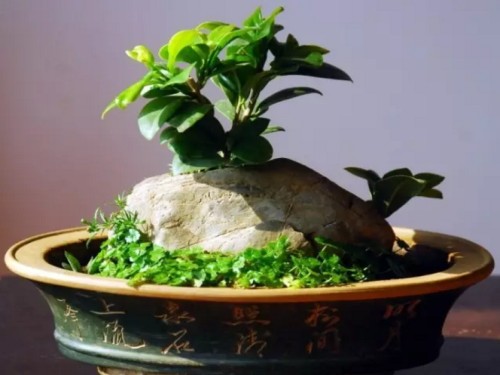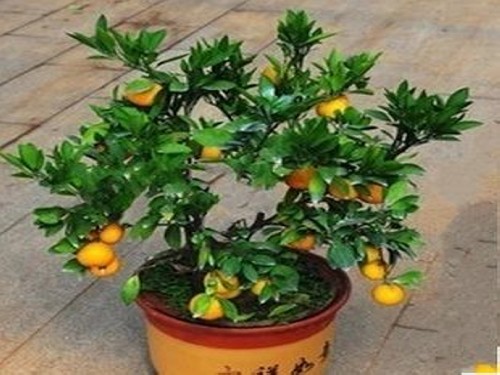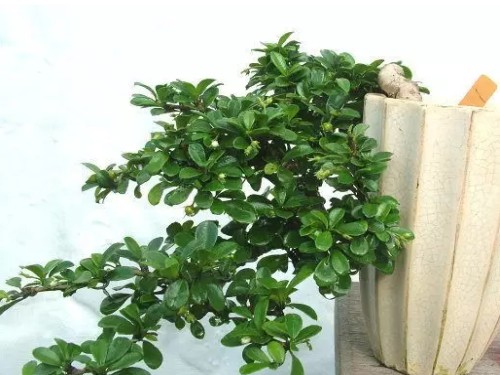Why did the banyan bonsai lose its leaves? What if the leaves of the banyan bonsai fall?
Banyan bonsai is one of our most common bonsai. It is evergreen, graceful and easy to maintain. After years of conservation of banyan bonsai, I feel that its more common problem is falling in love with leaves. On one occasion, her daughter put one of the banyan bonsai in her room for only two days, but on the third day there were a large number of fallen leaves, which scared her to move back to the yard. I examined the basin soil carefully and found it was moist, neither short of water nor stagnant. It was autumn at that time, and the temperature of the room was neither high nor low. Then what on earth is the cause of the fallen leaves?
According to my analysis, first, the air in the room is not as good as that in the courtyard; second, the light in the room is dark and there is not enough scattered light; third, the banyan bonsai is moved from the yard to the room, and the temperature difference is too large (this is the main factor). The combination of these three points led to a large number of fallen leaves of banyan bonsai.
We know that banyan is a tropical tree species, which likes warm, sunny, moist and ventilated environment. In our daily maintenance, we should follow these habits of the banyan tree and create a good environment suitable for the growth of the banyan tree so that it can thrive. Here are a few key points in cultivation:

1. Soil: be sure to use loose and permeable soil, and cover the basin with a layer of moss, which is not only beautiful, but also plays a good role in drainage and ventilation.
2. Sunshine: the banyan tree likes plenty of sunshine, which can make the plant strong. Even if there is no direct light, at least there must be bright scattered light. Of course, in the midsummer season, it is still necessary to avoid the fierce sun, so as not to burn the leaves. If you put it in a place that is too shady, it will definitely lose the yellow leaves.
3. Temperature: the banyan tree likes to be warm, and it should be kept above 5 degrees at least in winter, otherwise it will die instead of falling leaves. Especially in the north, it should be moved indoors for protection.
4. Moisture: the banyan tree requires the basin soil to be moist, so to what extent should it be watered before it is moist? For example, soak a towel in water, then pick it up and shake it straight and let it drip naturally. When it no longer drips, the moisture contained in the towel is in a "moist" state. Similarly, when the basin soil has been watered, the excess water will flow away from the bottom of the basin, and the basin soil in the basin is in a moist state. Therefore, the principle of "dry and wet" should be adopted in watering banyan trees. In other words, do not irrigate at will, but wait until the topsoil is dry, and water will not be watered until the basin bottom is overflowed. If the potted soil is too dry and wet, it will cause yellow leaves and fallen leaves.
5. Humidity: this humidity of course refers to the humidity of the air. As mentioned above, my daughter moved the banyan tree to the room and caused the fallen leaves, and the lack of humidity was also a reason. Therefore, to always keep the place moist, the only way to spray water is to spray water around the branches and leaves and the site. In our country, for example, the air is relatively dry, this work is even more important.
6. Fertilizer: banyan trees like fertilizer, and every 10 days and a half months in the growing season, all-element compound fertilizer, 500 times liquid, should be applied. Lack of nutrition is also a factor in the loss of leaves in banyan trees, which can not be ignored.
The banyan bonsai refers to the long-term control of its growth and development through pruning, pruning, hanging, or grafting for the purpose of viewing the stump shape and the strange shape of roots and leaves of the banyan tree, taking the banyan tree as the material. Make it a unique artistic shape of potted banyan. It is a magnificent and wonderful flower in flower bonsai, which is suitable for indoor decoration and courtyard decoration. Square, front door, road and other places can be displayed and watched, and it is loved by all walks of life.
"the banyan bonsai I bought last week was still green when I first got home, but a few days later I found that the leaves began to turn yellow and fall from the bottom, tried to put them in the sun or dropped them, dropped them back in the astigmatism, poured enough water, and returned them. I really don't know what to do!" The potted banyan tree at home lost its leaves, why did it lose its leaves? What should I do? Today, the editor will explain to you several possible reasons and countermeasures.
Why did the banyan bonsai lose its leaves? The main reasons for the defoliation of banyan bonsai are:
1. Improper watering. Banyan watering must adhere to the principle of not drying and watering thoroughly. Drying here means that the surface of the basin soil is dry, not thoroughly. Of course, even if it is dry, it will not cause great harm to the banyan tree in a short time, because the leaves of the banyan tree are thick and small, and have a certain degree of drought tolerance.
2. Improper fertilization. The fertilization of banyan tree needs to be carried out by applying thin fertilizer frequently to avoid the application of high concentration chemical fertilizer or unfermented mature organic fertilizer, otherwise it will cause fertilizer damage, the light ones will lose their leaves and the heavy ones will die.
3. Lack of light. The banyan tree grows well in the environment with sufficient light, and the leaf color is greener if it can shade 30-50% of the sun in summer, but it is best not to shade the sun when the temperature is lower than 32 ℃, so as not to lose the leaves.
4. Caused by insect pests. The main pests that lead to defoliation of banyan trees are red spiders and shell insects, although there are also "thrips", which only roll leaves to absorb juice, which is less harmful than the above two kinds, and thrips are easy to control and can only be removed and destroyed. The individual red spider is relatively small, and the general harmful part is the back of the leaf, which is caused by poor ventilation and dry air. The whole plant can be washed with water and sprayed with special mites, such as mites, acaroid mites and so on. The harmful parts of shell insects are mainly stems and petioles, with different size and color, round and oval in shape, and generally do not move, but they are harmful and need to be prevented and treated in time. They can be wiped clean with a toothbrush or dishcloth, or 0.2% solution of detergent and essential oil can be sprayed, or pesticides such as methamphetamidophos are sprayed with good results.
5. If dichlorvos is sprayed in the growing environment of banyan trees, it will also cause leaf shedding. In particular, money banyan is particularly sensitive to dichlorvos.
What if the leaves of the banyan bonsai fall? The following measures can be taken to solve the loss of leaves in banyan bonsai:
1, within four weeks, to less watering, usually only keep the cultivation substrate 5 or 60% wet on the line. Too much water will increase the chances of wound decay in the roots. The drier substrate is beneficial to the growth of new roots.
2. Shade 50% to 70%, or keep it in a semi-shaded environment for three to four weeks. Too strong light will increase transpiration.
3. Spray more foliar water to maintain high air humidity and moist leaves in the small environment, which can reduce the temperature of leaves, reduce transpiration of leaves and reduce the loss of water.
4. Soften the water quality. Ginseng banyan is native to the south and likes slightly acidic water and soil. Peat soil is recommended for cultivation, and the water used for irrigation also needs to be softened: soaking in a bucket of water after being wrapped in gauze with a jin of activated carbon or peat soil can reduce the pH of the water.
5. without considering fertilization within four weeks, there is a large amount of water and nutrients in the ginseng banyan body for it to consume for a period of time. Fertilize the root before the wound is fully healed. Not only can the root not absorb it, too much fertilizer will force the water from the root cell to flow back into the substrate. Four weeks later, it is recommended to use the nutrient solution sold in the flower market.
We must pay attention to the conservation of banyan bonsai, when encounter banyan bonsai leaves, pay attention to the surrounding temperature, humidity and other conditions, it is best to put banyan bonsai in a place where the sun can fully shine.
Time: 2019-06-01 Click:
- Prev

How to cultivate bonsai in orange trees
Many flower friends like the golden orange tree, but when they buy it, they don't know how to raise the kumquat tree, either losing the leaves or falling the fruit. In fact, it is not difficult to raise the kumquat tree, but it needs an adaptation process. The potted plants bought by the flower friends must have been raised in the pot all the time, but transplant temporarily.
- Next

How to lose the leaves of Fujian teapot scenery?
Fujian tea, also known as base tree and cat tree, is an evergreen shrub of Arnebiaceae. The leaves are small, long oval, dark green and shiny. White florets bloom in spring and summer, drupe globose, red after green. With its rugged trunk, colorful Qiu qu and elegant posture, it is one of the four major bonsai tree species in Lingnan, and it is also five species exported to the United States after China's entry into WTO.
Related
- Fuxing push coffee new agricultural production and marketing class: lack of small-scale processing plants
- Jujube rice field leisure farm deep ploughing Yilan for five years to create a space for organic food and play
- Nongyu Farm-A trial of organic papaya for brave women with advanced technology
- Four points for attention in the prevention and control of diseases and insect pests of edible fungi
- How to add nutrient solution to Edible Fungi
- Is there any good way to control edible fungus mites?
- Open Inoculation Technology of Edible Fungi
- Is there any clever way to use fertilizer for edible fungus in winter?
- What agents are used to kill the pathogens of edible fungi in the mushroom shed?
- Rapid drying of Edible Fungi

